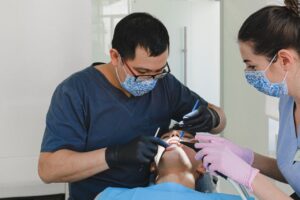Broken teeth, chipped, worn, or damaged teeth need to be fixed, but careful evaluation and considering options on the best way to restore your dental health in the long term is the first important step. In the first place, there needs to be an awareness of what caused these issues so that they don’t recur.
It is important to diagnose and treat broken teeth as part of a holistic oral health plan, regardless of the degree of your disease, taking into account your specific dental, medical, cosmetic, and social considerations and requirements, nutritional and lifestyle recommendations, and resolving any other stresses such as night grinding (bruxism).

What Causes Wear, Loss of the Tooth, and Broken Teeth?
Dental caries is one of the world’s most common illnesses. It is an inflammation of the hard tooth structure and decalcification caused by the acid by-products of bacteria.
If these bacteria are not properly removed by good brushing and flossing from the tooth surface, they start causing the tooth or root surface (enamel or cementum) to decalcify. It then causes cavitation and it becomes permanent and may become more damaging as it has breached into the deeper tooth structure. It may lead to discomfort, inflammation or pulp infection, abscesses, and… broken teeth if left untreated.
A number of other causes, such as nocturnal teeth grinding (bruxism), trauma, years of filling and dental repair, unhealthy bite, acid reflux, bulimia, poor enamel, genetic factors or lifestyle patterns, as well as excessive sugar and acid consumption, can also cause broken teeth or chipping.
A Tooth’s Structure
While the toughest substances in the human body are our teeth, they can be subject to harm and decay. First, the solid white outer part of the tooth (enamel) is on the outside. The dentin layer underlies the enamel and is thinner and more resistant to wear and rapid decay.
The pulp (and root canal), which can get infected if decay on the surface is not properly handled, is called the innermost structure. In certain cases, the periodontal ligament can also get infected, which helps keep the teeth firmly against the jaw, and this can affect the vital role that the teeth perform in tasks such as chewing or talking.
How Will Tooth Decay And Worn Down Teeth Be Fixed?
Under a local anaesthetic, a small chip or decayed part of the tooth may also be removed. If your tooth wear or breakdown is more extreme and widespread, during the consultation, you can opt to conduct more intensive reconstructive procedures such as a dental crown to improve results in a number of visits.
The most common dental treatment is to remove the tooth decay, stop the progression of dental decay and to repair the defect left behind in the tooth by direct restoration (filling) or indirectly manufactured restoration (inlay or onlay). More extensively damaged teeth may benefit from indirect restoration of the crown, and endodontic (root canal) treatment may be needed for those with infected pulp or nerve tissue.
When to Get a Total Replacement for Teeth?
If you have a failing dentition (all teeth and gums seriously ill or infected), then in the long run, a “big picture” solution can be wiser and more cost-effective than continuous dentistry patch up and one-by-one” tooth removals.
You can suffer from jaw bone shrinkage over time if you have many or completely missing teeth. The loss of bone mass will progress even when you use your removable dentures, since there are no natural teeth that stimulate the jaw bone. In the long term, this bone atrophy makes it harder or almost impossible to take advantage of traditional implant teeth.
Please make an appointment with our Family Dentists for more information.



















































 I highly recommend this clinic for everyone’s dental needs.
I highly recommend this clinic for everyone’s dental needs.

